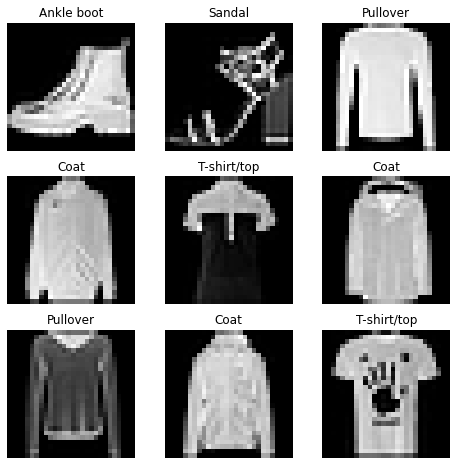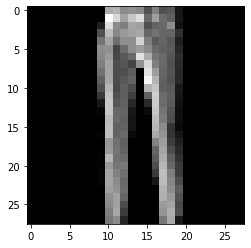Dataset 和 Dataloader
内容
Dataset 和 Dataloader¶
torch.autograd 实现自动微分
处理数据样本的代码可能会变得混乱且难以维护;理想情况下,希望数据集代码与模型训练代码解耦,以获得更好的可读性和模块化。PyTorch 提供了两个数据原语:torch.utils.data.DataLoader 和 torch.utils.data.Dataset,它们允许使用预加载的数据集以及自定义的数据。Dataset 存储样本及其相应的标签,DataLoader 在 Dataset 周围包装一个可迭代对象以方便访问样本。
PyTorch 域库提供了许多预加载的数据集(比如 Fashion MNIST),这些数据集继承了 torch.utils.data.Dataset 的子类,并实现了特定于特定数据的函数。它们可以用于模型原型(prototype)和基准测试(benchmark)。细节见 图像数据集,文本数据集 和音频数据集。
加载 Dataset¶
下面是如何从 TorchVision 加载 Fashion MNIST 数据集的示例。Fashion MNIST 是 Zalando 文章图像的数据集,包含 \(60\,000\) 个训练样本和 \(10\,000\) 个测试样本。
加载 Fashion MNIST 数据集的参数:
root是存储 train/test 数据的路径train指定训练或测试数据集download=True如果数据在根目录下不可用,则从互联网上下载数据transform和target_transform指定特征和标签变换
import torch
from torch.utils.data import Dataset
from torchvision import datasets
from torchvision.transforms import ToTensor
import matplotlib.pyplot as plt
root = '../../datasets'
training_data = datasets.FashionMNIST(
root=root,
train=True,
download=True,
transform=ToTensor()
)
test_data = datasets.FashionMNIST(
root=root,
train=False,
download=True,
transform=ToTensor()
)
C:\Users\xinet\.conda\envs\torch\lib\site-packages\torchvision\datasets\mnist.py:498: UserWarning: The given NumPy array is not writeable, and PyTorch does not support non-writeable tensors. This means you can write to the underlying (supposedly non-writeable) NumPy array using the tensor. You may want to copy the array to protect its data or make it writeable before converting it to a tensor. This type of warning will be suppressed for the rest of this program. (Triggered internally at ..\torch\csrc\utils\tensor_numpy.cpp:180.)
return torch.from_numpy(parsed.astype(m[2], copy=False)).view(*s)
迭代和可视化 Dataset¶
可以像
training_data[index]那样手动索引数据集。使用
matplotlib可视化训练数据中的一些样本。
labels_map = training_data.classes # 获取类别列表
figure = plt.figure(figsize=(8, 8))
cols, rows = 3, 3
for i in range(1, cols * rows + 1):
sample_idx = torch.randint(len(training_data), size=(1,)).item()
img, label = training_data[sample_idx]
figure.add_subplot(rows, cols, i)
plt.title(labels_map[label])
plt.axis("off")
plt.imshow(img.squeeze(), cmap="gray")
plt.show()

创建自定义数据集¶
自定义数据集类必须实现三个函数:__init__, __len__ 和 __getitem__。比如 FashionMNIST 图像存储在一个目录 img_dir 中,它们的标签分别存储在一个 CSV 文件 annotations_file 中。
import os
import pandas as pd
from torchvision.io import read_image
class CustomImageDataset(Dataset):
def __init__(self, annotations_file, img_dir, transform=None, target_transform=None):
self.img_labels = pd.read_csv(annotations_file)
self.img_dir = img_dir
self.transform = transform
self.target_transform = target_transform
def __len__(self):
return len(self.img_labels)
def __getitem__(self, idx):
img_path = os.path.join(self.img_dir, self.img_labels.iloc[idx, 0])
image = read_image(img_path)
label = self.img_labels.iloc[idx, 1]
if self.transform:
image = self.transform(image)
if self.target_transform:
label = self.target_transform(label)
return image, label
__init__¶
__init__ 函数在实例化 Dataset 对象时运行一次。初始化包含图像、标注文件和这两种变换的目录。
labels.csv 文件看起来像这样:
tshirt1.jpg, 0
tshirt2.jpg, 0
......
ankleboot999.jpg, 9
__len__¶
__len__ 函数返回数据集中的样本数量。
__getitem__¶
__getitem__ 函数从数据集的给定索引 idx 处加载并返回一个样本。基于索引,它识别图像在磁盘上的位置,使用 read_image 将其转换为张量,从在 self.img_labels 中的 csv 数据检索相应的标签,调用它们的变换函数(如果适用),并返回张量图像和相应的标签组成的元组。
使用 DataLoader 准备训练数据¶
Dataset 检索我们的数据集的特征和标签,且一次一个样本。在训练模型时,通常希望以“小批量”的方式通过样本,在每个 epoch 重新编排数据以减少模型过拟合,并使用 Python 的 multiprocessing 来加快数据检索。
DataLoader 是一个可迭代对象,它在一个简单的 API 中为我们抽象了这种复杂性。
from torch.utils.data import DataLoader
train_dataloader = DataLoader(training_data, batch_size=64, shuffle=True)
test_dataloader = DataLoader(test_data, batch_size=64, shuffle=True)
遍历 DataLoader¶
已经将该数据集加载到 Dataloader 中,并可以根据需要遍历该数据集。下面的每次迭代返回一批 train_features 和 train_labels(分别包含 batch_size=64 个特征和标签)。因为指定了 shuffle=True,所以在遍历所有批次之后,数据被打乱(为了更细粒度地控制数据加载顺序,请查看 Samplers)。
# Display image and label.
train_features, train_labels = next(iter(train_dataloader))
print(f"Feature batch shape: {train_features.size()}")
print(f"Labels batch shape: {train_labels.size()}")
img = train_features[0].squeeze()
label = train_labels[0]
plt.imshow(img, cmap="gray")
plt.show()
print(f"Label: {label}")
Feature batch shape: torch.Size([64, 1, 28, 28])
Labels batch shape: torch.Size([64])

Label: 1
